stop start INFINITI Q50 2018 Workshop Manual
[x] Cancel search | Manufacturer: INFINITI, Model Year: 2018, Model line: Q50, Model: INFINITI Q50 2018Pages: 458, PDF Size: 2.13 MB
Page 311 of 458
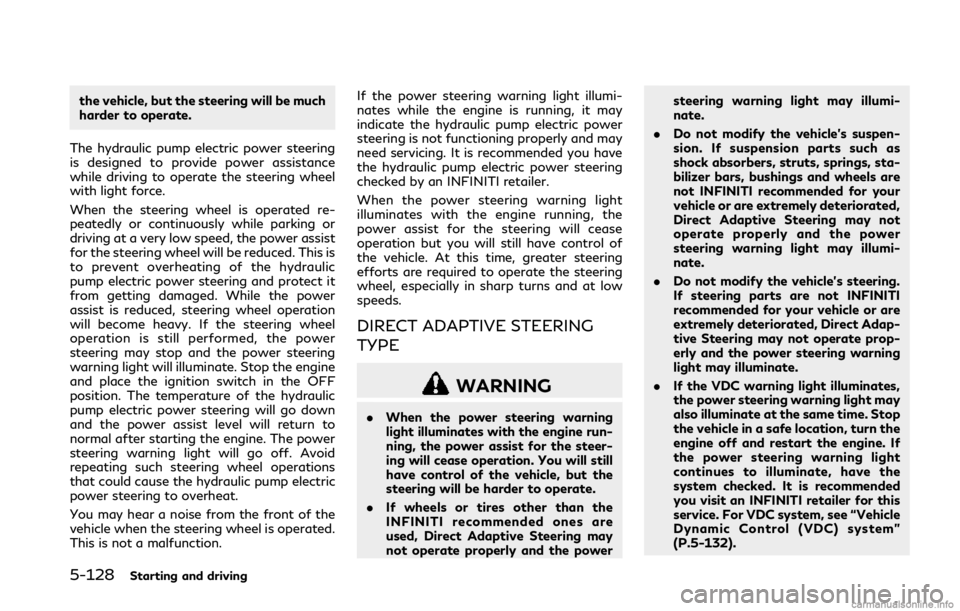
5-128Starting and driving
the vehicle, but the steering will be much
harder to operate.
The hydraulic pump electric power steering
is designed to provide power assistance
while driving to operate the steering wheel
with light force.
When the steering wheel is operated re-
peatedly or continuously while parking or
driving at a very low speed, the power assist
for the steering wheel will be reduced. This is
to prevent overheating of the hydraulic
pump electric power steering and protect it
from getting damaged. While the power
assist is reduced, steering wheel operation
will become heavy. If the steering wheel
operation is still performed, the power
steering may stop and the power steering
warning light will illuminate. Stop the engine
and place the ignition switch in the OFF
position. The temperature of the hydraulic
pump electric power steering will go down
and the power assist level will return to
normal after starting the engine. The power
steering warning light will go off. Avoid
repeating such steering wheel operations
that could cause the hydraulic pump electric
power steering to overheat.
You may hear a noise from the front of the
vehicle when the steering wheel is operated.
This is not a malfunction. If the power steering warning light illumi-
nates while the engine is running, it may
indicate the hydraulic pump electric power
steering is not functioning properly and may
need servicing. It is recommended you have
the hydraulic pump electric power steering
checked by an INFINITI retailer.
When the power steering warning light
illuminates with the engine running, the
power assist for the steering will cease
operation but you will still have control of
the vehicle. At this time, greater steering
efforts are required to operate the steering
wheel, especially in sharp turns and at low
speeds.
DIRECT ADAPTIVE STEERING
TYPE
WARNING
.
When the power steering warning
light illuminates with the engine run-
ning, the power assist for the steer-
ing will cease operation. You will still
have control of the vehicle, but the
steering will be harder to operate.
. If wheels or tires other than the
INFINITI recommended ones are
used, Direct Adaptive Steering may
not operate properly and the power steering warning light may illumi-
nate.
. Do not modify the vehicle’s suspen-
sion. If suspension parts such as
shock absorbers, struts, springs, sta-
bilizer bars, bushings and wheels are
not INFINITI recommended for your
vehicle or are extremely deteriorated,
Direct Adaptive Steering may not
operate properly and the power
steering warning light may illumi-
nate.
. Do not modify the vehicle’s steering.
If steering parts are not INFINITI
recommended for your vehicle or are
extremely deteriorated, Direct Adap-
tive Steering may not operate prop-
erly and the power steering warning
light may illuminate.
. If the VDC warning light illuminates,
the power steering warning light may
also illuminate at the same time. Stop
the vehicle in a safe location, turn the
engine off and restart the engine. If
the power steering warning light
continues to illuminate, have the
system checked. It is recommended
you visit an INFINITI retailer for this
service. For VDC system, see “Vehicle
Dynamic Control (VDC) system”
(P.5-132).
Page 312 of 458
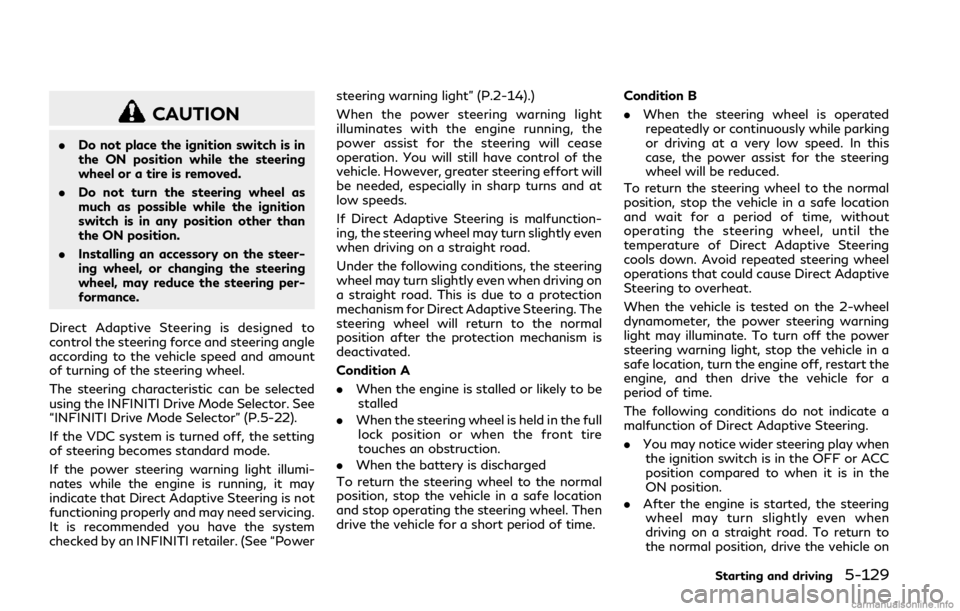
CAUTION
.Do not place the ignition switch is in
the ON position while the steering
wheel or a tire is removed.
. Do not turn the steering wheel as
much as possible while the ignition
switch is in any position other than
the ON position.
. Installing an accessory on the steer-
ing wheel, or changing the steering
wheel, may reduce the steering per-
formance.
Direct Adaptive Steering is designed to
control the steering force and steering angle
according to the vehicle speed and amount
of turning of the steering wheel.
The steering characteristic can be selected
using the INFINITI Drive Mode Selector. See
“INFINITI Drive Mode Selector” (P.5-22).
If the VDC system is turned off, the setting
of steering becomes standard mode.
If the power steering warning light illumi-
nates while the engine is running, it may
indicate that Direct Adaptive Steering is not
functioning properly and may need servicing.
It is recommended you have the system
checked by an INFINITI retailer. (See “Power steering warning light” (P.2-14).)
When the power steering warning light
illuminates with the engine running, the
power assist for the steering will cease
operation. You will still have control of the
vehicle. However, greater steering effort will
be needed, especially in sharp turns and at
low speeds.
If Direct Adaptive Steering is malfunction-
ing, the steering wheel may turn slightly even
when driving on a straight road.
Under the following conditions, the steering
wheel may turn slightly even when driving on
a straight road. This is due to a protection
mechanism for Direct Adaptive Steering. The
steering wheel will return to the normal
position after the protection mechanism is
deactivated.
Condition A
.
When the engine is stalled or likely to be
stalled
. When the steering wheel is held in the full
lock position or when the front tire
touches an obstruction.
. When the battery is discharged
To return the steering wheel to the normal
position, stop the vehicle in a safe location
and stop operating the steering wheel. Then
drive the vehicle for a short period of time. Condition B
.
When the steering wheel is operated
repeatedly or continuously while parking
or driving at a very low speed. In this
case, the power assist for the steering
wheel will be reduced.
To return the steering wheel to the normal
position, stop the vehicle in a safe location
and wait for a period of time, without
operating the steering wheel, until the
temperature of Direct Adaptive Steering
cools down. Avoid repeated steering wheel
operations that could cause Direct Adaptive
Steering to overheat.
When the vehicle is tested on the 2-wheel
dynamometer, the power steering warning
light may illuminate. To turn off the power
steering warning light, stop the vehicle in a
safe location, turn the engine off, restart the
engine, and then drive the vehicle for a
period of time.
The following conditions do not indicate a
malfunction of Direct Adaptive Steering.
. You may notice wider steering play when
the ignition switch is in the OFF or ACC
position compared to when it is in the
ON position.
. After the engine is started, the steering
wheel may turn slightly even when
driving on a straight road. To return to
the normal position, drive the vehicle on
Starting and driving5-129
Page 313 of 458
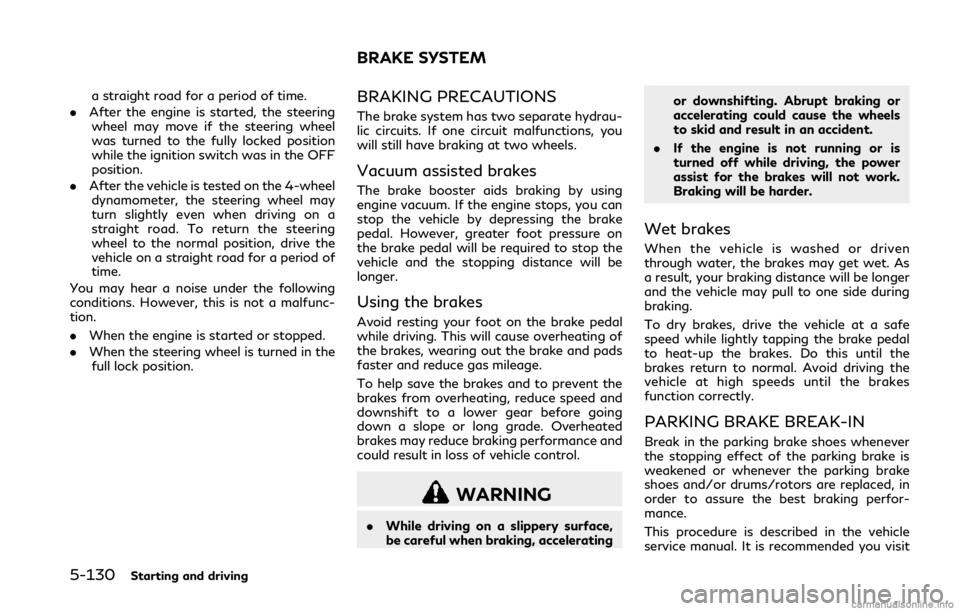
5-130Starting and driving
a straight road for a period of time.
. After the engine is started, the steering
wheel may move if the steering wheel
was turned to the fully locked position
while the ignition switch was in the OFF
position.
. After the vehicle is tested on the 4-wheel
dynamometer, the steering wheel may
turn slightly even when driving on a
straight road. To return the steering
wheel to the normal position, drive the
vehicle on a straight road for a period of
time.
You may hear a noise under the following
conditions. However, this is not a malfunc-
tion.
. When the engine is started or stopped.
. When the steering wheel is turned in the
full lock position.BRAKING PRECAUTIONS
The brake system has two separate hydrau-
lic circuits. If one circuit malfunctions, you
will still have braking at two wheels.
Vacuum assisted brakes
The brake booster aids braking by using
engine vacuum. If the engine stops, you can
stop the vehicle by depressing the brake
pedal. However, greater foot pressure on
the brake pedal will be required to stop the
vehicle and the stopping distance will be
longer.
Using the brakes
Avoid resting your foot on the brake pedal
while driving. This will cause overheating of
the brakes, wearing out the brake and pads
faster and reduce gas mileage.
To help save the brakes and to prevent the
brakes from overheating, reduce speed and
downshift to a lower gear before going
down a slope or long grade. Overheated
brakes may reduce braking performance and
could result in loss of vehicle control.
WARNING
. While driving on a slippery surface,
be careful when braking, accelerating or downshifting. Abrupt braking or
accelerating could cause the wheels
to skid and result in an accident.
. If the engine is not running or is
turned off while driving, the power
assist for the brakes will not work.
Braking will be harder.
Wet brakes
When the vehicle is washed or driven
through water, the brakes may get wet. As
a result, your braking distance will be longer
and the vehicle may pull to one side during
braking.
To dry brakes, drive the vehicle at a safe
speed while lightly tapping the brake pedal
to heat-up the brakes. Do this until the
brakes return to normal. Avoid driving the
vehicle at high speeds until the brakes
function correctly.
PARKING BRAKE BREAK-IN
Break in the parking brake shoes whenever
the stopping effect of the parking brake is
weakened or whenever the parking brake
shoes and/or drums/rotors are replaced, in
order to assure the best braking perfor-
mance.
This procedure is described in the vehicle
service manual. It is recommended you visit
BRAKE SYSTEM
Page 314 of 458
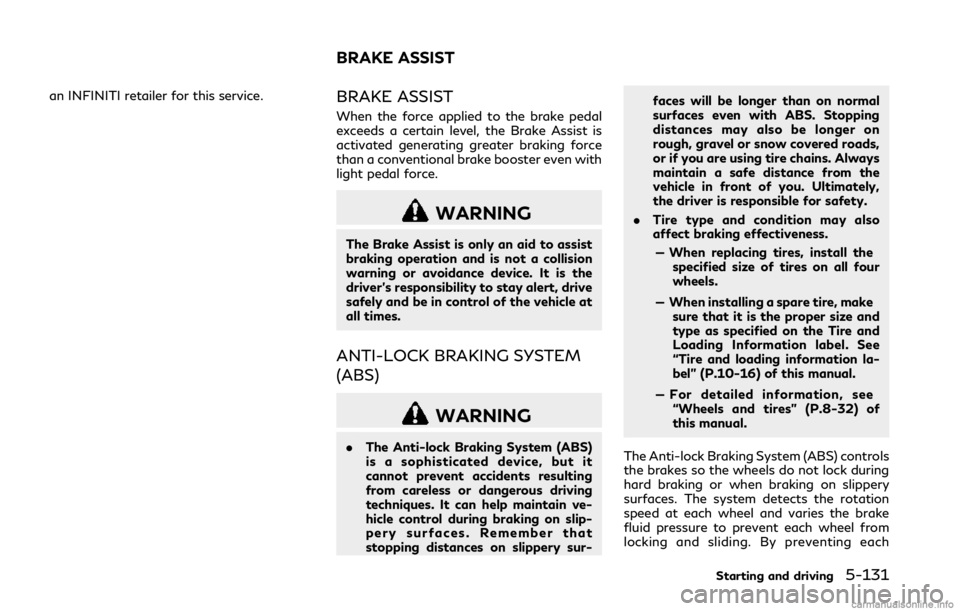
an INFINITI retailer for this service.BRAKE ASSIST
When the force applied to the brake pedal
exceeds a certain level, the Brake Assist is
activated generating greater braking force
than a conventional brake booster even with
light pedal force.
WARNING
The Brake Assist is only an aid to assist
braking operation and is not a collision
warning or avoidance device. It is the
driver’s responsibility to stay alert, drive
safely and be in control of the vehicle at
all times.
ANTI-LOCK BRAKING SYSTEM
(ABS)
WARNING
. The Anti-lock Braking System (ABS)
is a sophisticated device, but it
cannot prevent accidents resulting
from careless or dangerous driving
techniques. It can help maintain ve-
hicle control during braking on slip-
pery surfaces. Remember that
stopping distances on slippery sur- faces will be longer than on normal
surfaces even with ABS. Stopping
distances may also be longer on
rough, gravel or snow covered roads,
or if you are using tire chains. Always
maintain a safe distance from the
vehicle in front of you. Ultimately,
the driver is responsible for safety.
. Tire type and condition may also
affect braking effectiveness.
— When replacing tires, install the specified size of tires on all four
wheels.
— When installing a spare tire, make sure that it is the proper size and
type as specified on the Tire and
Loading Information label. See
“Tire and loading information la-
bel” (P.10-16) of this manual.
— For detailed information, see “Wheels and tires” (P.8-32) of
this manual.
The Anti-lock Braking System (ABS) controls
the brakes so the wheels do not lock during
hard braking or when braking on slippery
surfaces. The system detects the rotation
speed at each wheel and varies the brake
fluid pressure to prevent each wheel from
locking and sliding. By preventing each
Starting and driving5-131
BRAKE ASSIST
Page 315 of 458

5-132Starting and driving
wheel from locking, the system helps the
driver maintain steering control and helps to
minimize swerving and spinning on slippery
surfaces.
Using the system
Depress the brake pedal and hold it down.
Depress the brake pedal with firm steady
pressure, but do not pump the brakes. The
ABS will operate to prevent the wheels from
locking up. Steer the vehicle to avoid
obstacles.
WARNING
Do not pump the brake pedal. Doing so
may result in increased stopping dis-
tances.
Self-test feature
The ABS includes electronic sensors, electric
pumps, hydraulic solenoids and a computer.
The computer has a built-in diagnostic
feature that tests the system each time you
start the engine and move the vehicle at a
low speed in forward or reverse. When the
self-test occurs, you may hear a “clunk”
noise and/or feel a pulsation in the brake
pedal. This is normal and does not indicate a
malfunction. If the computer senses a mal-function, it switches the ABS off and
illuminates the ABS warning light on the
instrument panel. The brake system then
operates normally, but without anti-lock
assistance.
If the ABS warning light illuminates during
the self-test or while driving, have the
vehicle checked. It is recommended you visit
an INFINITI retailer for this service.
Normal operation
The ABS operates at speeds above 3 to 6
MPH (5 to 10 km/h).
When the ABS senses that one or more
wheels are close to locking up, the actuator
rapidly applies and releases hydraulic pres-
sure. This action is similar to pumping the
brakes very quickly. You may feel a pulsation
in the brake pedal and hear a noise from
under the hood or feel a vibration from the
actuator when it is operating. This is normal
and indicates that the ABS is operating
properly. However, the pulsation may indi-
cate that road conditions are hazardous and
extra care is required while driving.
The Vehicle Dynamic Control (VDC) system
uses various sensors to monitor driver inputs
and vehicle motion. Under certain driving
conditions, the VDC system helps to perform
the following functions.
.
Controls brake pressure to reduce wheel
slip on one slipping drive wheel so power
is transferred to a non slipping drive
wheel on the same axle.
. Controls brake pressure and engine out-
put to reduce drive wheel slip based on
vehicle speed (traction control function).
. Controls brake pressure at individual
wheels and engine output to help the
driver maintain control of the vehicle in
the following conditions:
— understeer (vehicle tends to not follow the steered path despite increased
steering input)
— oversteer (vehicle tends to spin due to certain road or driving conditions).
The VDC system can help the driver to
maintain control of the vehicle, but it cannot
prevent loss of vehicle control in all driving
situations.
When the VDC system operates, the VDC
warning light
in the instrument panel
flashes so note the following:
. The road may be slippery or the system
may determine some action is required to
help keep the vehicle on the steered path.
VEHICLE DYNAMIC CONTROL
(VDC) SYSTEM
Page 319 of 458

5-136Starting and driving
WARNING
.Never rely solely on the hill start
assist system to prevent the vehicle
from moving backward on a hill.
Always drive carefully and atten-
tively. Depress the brake pedal when
the vehicle is stopped on a steep hill.
Be especially careful when stopped
on a hill on frozen or muddy roads.
Failure to prevent the vehicle from
rolling backwards may result in a loss
of control of the vehicle and possible
serious injury or death.
. The hill start assist system is not
designed to hold the vehicle at a
standstill on a hill. Depress the brake
pedal when the vehicle is stopped on
a steep hill. Failure to do so may
cause the vehicle to roll backwards
and may result in a collision or serious
personal injury.
. The hill start assist system may not
prevent the vehicle from rolling back-
wards on a hill under all load or road
conditions. Always be prepared to
depress the brake pedal to prevent
the vehicle from rolling backwards.
Failure to do so may result in a
collision or serious personal injury. The hill start assist system automatically
keeps the brakes applied to help prevent the
vehicle from rolling backwards in the time it
takes the driver to release the brake pedal
and apply the accelerator when the vehicle is
stopped on a hill.
The hill start assist system will operate
automatically under the following condi-
tions:
.
The transmission is shifted to a forward
or reverse gear.
. The vehicle is stopped completely on a hill
by applying the brake.
The maximum holding time is 2 seconds.
After 2 seconds the vehicle will begin to roll
back and the hill start assist system will stop
operating completely.
The hill start assist system will not operate
when the transmission is shifted to the N
(Neutral) or P (Park) position or on a flat and
level road. The chassis control is an electric control
module that includes the following func-
tions:
.
Log-in function (See “Log-in function”
(P.3-16).)
. INFINITI Drive Mode Selector (See
“INFINITI Drive Mode Selector” (P.5-
22).)
. Active Lane Control (if so equipped) (See
“Active Lane Control” (P.5-26).)
. Active Trace Control (See “Active trace
control” (P.5-134).)
HILL START ASSIST SYSTEM CHASSIS CONTROL
Page 320 of 458
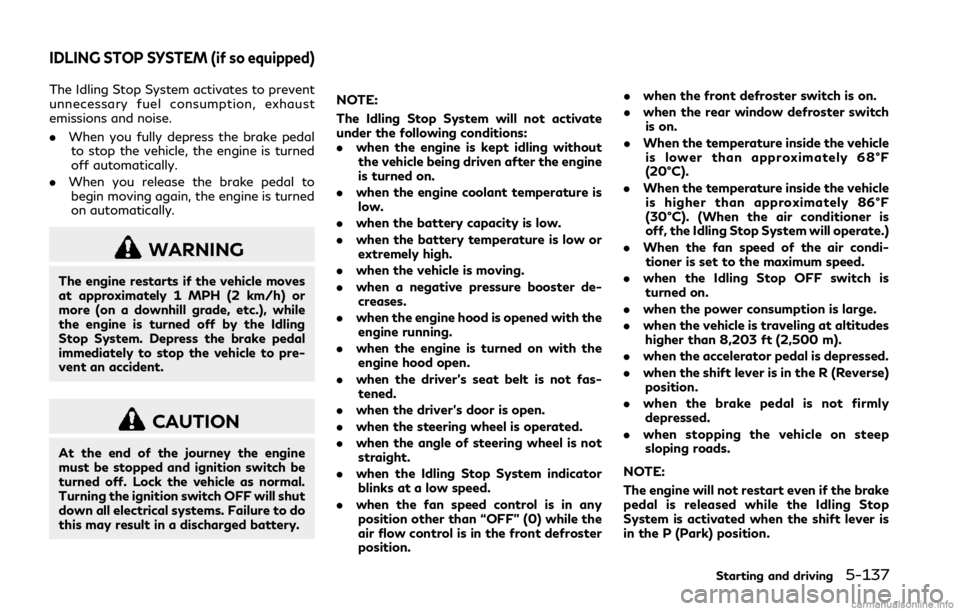
The Idling Stop System activates to prevent
unnecessary fuel consumption, exhaust
emissions and noise.
.When you fully depress the brake pedal
to stop the vehicle, the engine is turned
off automatically.
. When you release the brake pedal to
begin moving again, the engine is turned
on automatically.
WARNING
The engine restarts if the vehicle moves
at approximately 1 MPH (2 km/h) or
more (on a downhill grade, etc.), while
the engine is turned off by the Idling
Stop System. Depress the brake pedal
immediately to stop the vehicle to pre-
vent an accident.
CAUTION
At the end of the journey the engine
must be stopped and ignition switch be
turned off. Lock the vehicle as normal.
Turning the ignition switch OFF will shut
down all electrical systems. Failure to do
this may result in a discharged battery. NOTE:
The Idling Stop System will not activate
under the following conditions:
.
when the engine is kept idling without
the vehicle being driven after the engine
is turned on.
. when the engine coolant temperature is
low.
. when the battery capacity is low.
. when the battery temperature is low or
extremely high.
. when the vehicle is moving.
. when a negative pressure booster de-
creases.
. when the engine hood is opened with the
engine running.
. when the engine is turned on with the
engine hood open.
. when the driver’s seat belt is not fas-
tened.
. when the driver’s door is open.
. when the steering wheel is operated.
. when the angle of steering wheel is not
straight.
. when the Idling Stop System indicator
blinks at a low speed.
. when the fan speed control is in any
position other than “OFF” (0) while the
air flow control is in the front defroster
position. .
when the front defroster switch is on.
. when the rear window defroster switch
is on.
. When the temperature inside the vehicle
is lower than approximately 68°F
(20°C).
. When the temperature inside the vehicle
is higher than approximately 86°F
(30°C). (When the air conditioner is
off, the Idling Stop System will operate.)
. When the fan speed of the air condi-
tioner is set to the maximum speed.
. when the Idling Stop OFF switch is
turned on.
. when the power consumption is large.
. when the vehicle is traveling at altitudes
higher than 8,203 ft (2,500 m).
. when the accelerator pedal is depressed.
. when the shift lever is in the R (Reverse)
position.
. when the brake pedal is not firmly
depressed.
. when stopping the vehicle on steep
sloping roads.
NOTE:
The engine will not restart even if the brake
pedal is released while the Idling Stop
System is activated when the shift lever is
in the P (Park) position.
Starting and driving5-137
IDLING STOP SYSTEM (if so equipped)
Page 321 of 458

5-138Starting and driving
NOTE:
It may take some time until the Idling Stop
System activates under the following con-
ditions:
.when the battery is discharged.
. when the outside temperature is low or
high.
. when the battery is replaced or the
battery terminal is disconnected for
extended periods and then reconnected.
NOTE:
When the Idling Stop System indicator light
illuminates, the engine starts running auto-
matically under at least one of the following
conditions:
. The brake pedal is released with the shift
lever in the D (Drive) or N (Neutral)
position.
. The shift lever is placed in the D (Drive)
or R (Reverse) position from the N
(Neutral) or P (Park) position.
. The driver’s seat belt is unfastened, or
the driver’s door is open.
. The battery voltage becomes low (due to
electrical load from other vehicle sys-
tems like headlights, heaters, etc., or
auxiliary devices connected to the 12
volt socket inside the vehicle).
. The vehicle speed is above about 1 MPH
(2 km/h). .
The front defroster is operated.
. The rear window defroster is operated.
. When the temperature inside the vehicle
is lower than approximately 68°F
(20°C).
. When the temperature inside the vehicle
is higher than approximately 86°F
(30°C). (When the air conditioner is
off, the Idling Stop System will operate.)
. When the front defroster is turned on.
(The engine may not starts depending
on the outside temperature.)
. When more than 3 minutes have elapsed
since the Idling Stop System was active.
. When the accelerator pedal is depressed.
. When the steering wheel is operated.
(The steering wheel operation may be-
come heavy, but this is not a malfunc-
tion.)
. When the battery capacity is low.
. When the power consumption is high.
. When the shift lever is placed in the R
(Reverse) position.
NOTE:
The following condition will prevent the
Idling Stop System from automatically re-
starting the engine. Starting the engine
with the ignition switch operation is then
necessary: .
The hood is open.
Use this system while waiting at stoplight,
etc. When the vehicle is stopped for long
periods of time, turn off the engine.
When the engine is stopped by the Idling
Stop System, heating, cooling and dehumi-
difying functions will be deactivated. To
avoid the air conditioning functions from
being deactivated, turn off the Idling Stop
mode by pushing the Idling Stop OFF switch.
RETROGRADE MOVEMENT
CONTROL FUNCTION
This system is designed to reduce the retro-
grade movement that occurs while the
driver’s foot changes from depressing the
brake pedal to the accelerator pedal when
moving the vehicle while the Idling Stop
System is active on a hilly road.
IDLING STOP SYSTEM DISPLAY
The status of the Idling Stop System can be
checked in the vehicle information display.
Page 322 of 458

JVS0342X
Idling Stop System ON or OFF
If the Idling Stop System is activated or
deactivated using the Idling Stop OFF
switch, the message is shown.
JVS0904X
Fuel saved and engine stop time
The fuel saved and the engine stop time
mode shows the following items:
.The fuel saved shows the estimated
quantity of fuel that were saved by the
Idling Stop System every time the engine
is automatically stopped.
. The engine stop time shows the time that
the engine has been stopped for by the
Idling Stop System.
The total fuel saved and the engine stop time
can also be checked in the vehicle informa-
tion display. See “4. Trip fuel saved and
engine stop time” (P.2-27) and “5. Total fuel
saved and engine stop time” (P.2-28).
JVS0344X
Auto start deactivation
If the engine stops when the Idling Stop
System is activated, and will not start
automatically, the message is shown.
Starting and driving5-139
Page 323 of 458

5-140Starting and driving
JVS0345X
Key LOCK warning
The information is displayed and a buzzer
sounded to remind the driver to place the
ignition switch in the OFF position to avoid a
discharged battery.
The message can be cleared by placing the
ignition switch in the OFF position (or
restarting the engine) or pushing the
orswitch on the steering wheel.
JVS0346X
System fault
This message is displayed when the Idling
Stop System is malfunctioning.
It is recommended you have the system
checked by an INFINITI retailer.
JVS0269X
IDLING STOP OFF SWITCH
The system can be temporarily deactivated
by pushing the Idling Stop OFF switch.
Pushing the switch again or restarting the
engine by using the ignition switch will
reactivate the Idling Stop System.
.When the Idling Stop System is deacti-
vated while the engine is running, the
engine is prevented from automatically
stopping.
. When the Idling Stop System is deacti-
vated after the engine has been auto-
matically stopped by the Idling Stop
System, the engine will immediately
restart if suitable conditions are present.
The engine will then be prevented from